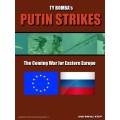Putin Strikes : The Coming War for Eastern Europe
OSS2163
- English
- From 12 years old
- 3 to 4h, 2 to 3h
- 2 player(s)
Putin Strikes: The Coming War for Eastern Europe is a two-player game in which one player commands the Kremlin's forces, and the other commands a polyglot international coalition opposed to him.
Putin Strikes: The Coming War for Eastern Europe isn't a simulation of the "opaque (a.k.a. gray) war" techniques most recently used by the Russians in the Crimea and eastern Ukraine. Rather, it's designed to facilitate the examination of the strategic possibilities (along with their operational undertones) inherent in the larger situation. That is, it models the parameters of possibilities if Putin decides to go all out--taking advantage of the democratic West's increasing befuddlement by the jihad--to make one quick blitzkrieg-like strike to grab Russia's western "Near Abroad."
Each turn of play equals half a week of real time. Each hexagon on the map represents 20 miles (32.5 km) from side to opposite side. The system is based around the central idea that large First World armies (as well as those from elsewhere that have been trained and equipped to try to perform like First World armies) almost always begin major wars seemingly well prepared. Unfortunately for those in their front-line units, both the training and equipment usually only make them ready for the previous war, not the one they're about to fight. Beyond that, the initial period of such wars is characterized by only a partially abandoned peacetime psychology among the officers and enlisted. That is, no one as yet appreciates what it means operatively to be in an all-out war. All that comes together to give overall performance high-risk, volatile and fragile qualities: no one as yet really knows what's actually possible or wise to try to accomplish. Seemingly powerful units therefore easily become "disrupted"--especially as gauged in relation to similar units' performances later, after everyone's been thoroughly schooled in the art of war as it exists in the present. The system therefore doesn't play--when looked at on a step by step basis--in a way common to division-level simulations. The whole thing has a "Go" like quality to it. The commander will succeed best who--rather than reacting to or launching operations opportunistically one at a time--plans his campaign and then campaigns on that plan. Of course, we all know it's also true "no plan survives first contact with the enemy." So, even as you plan, you must do so while leaving within your overall scheme at least some capacity for opportunism. Strategy is not simple; it is complex.
The design explores the philosophic backlash that seems to be building throughout First World militaries in regard to the increasing organizational dominance of brigades over divisions. That is, even as the former have increasingly come to be the unit-of-choice at both operational and strategic levels, there's growing concern in the literature that brigades may be too large to employ the dexterity needed in counterinsurgency operations while also being too small to hold up for long in any force-on-force shootouts between First World opponents. Hence the contrasting characteristics generated by the differences in size between brigades and divisions are highlighted.
Copyright © 2025 www.philibertnet.com Legals - Privacy Policy - Cookie Preferences - Sitemap







